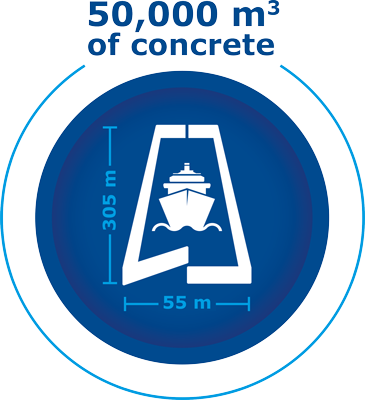FROM TV TOWERS TO THE A40 AUTOBAHN.
What do TV towers, canal locks and autobahns have in common? They are all built using high-quality construction materials containing slag. This resource-saving raw material is present in cement and concrete, and is used in road and transport construction.
This is no coincidence, because the quality of these products is continuously improving. The FEhS Building Materials Institute in Duisburg makes sure of it. These slag professionals are not only researching and testing, but have also been supporting companies, institutions and authorities with advice and assistance for decades.

More than 100,000 vehicles per day roll over the A40 autobahn in the Ruhr area, which contains open-pore asphalt slag.
The architects and engineers were already relying on the quality of cement and concrete manufactured using ground granulated blast furnace slag or air-cooled blast furnace slag many decades ago, what known structures prove: e.g. the Sprinkenhof office complex in Hamburg and the Lichtburg House in Essen from the 1920s, or the Hohenwarte dam which was built in the 1930s.
The technical and ecological requirements for high-quality cement and concrete, and thus the guarantee of safe, reliable structures, have continuously increased over recent decades: long-term durability, high strength and load-bearing capacity, resistance to chemical attack, protection against water-polluting liquids, frost resistance, and impermeability are just a few of them.
It is therefore no surprise that the list of modern properties made from construction materials containing granulated blast furnace slag is long. They include well known office buildings, such as the WDR state studios in Düsseldorf and the Neue Zollhof building in MedienHafen Düsseldorf, the TV towers in Dortmund and Düsseldorf, and bridges, canal locks, wastewater treatment plants, biogas plants, coal silos, road surfaces made from asphalt or concrete, drinking water pipelines and chimneys.
Further examples can be found here.
Not just the construction industry, however, but also the agriculture sector has been relying on slag for over 100 years. Today half a million tonnes are processed into fertiliser each year, predominantly in the form of converter lime. Like their colleagues in construction, the agriculture industry values its impressive product qualities and environmental safety – here, too, the FEhS Institute works together with its partners to continuously optimise the products and guarantee high quality.
Further examples can be found here.

The Panama Canal of the North. From 2007 to 2011 over 50,000 m3 of concrete have been used for the construction of the Kaiserschleuse lock in the international port area Bremerhaven. The 305 metre long structure has a clearance width of 55 metres – just like the new Panama Canal!



